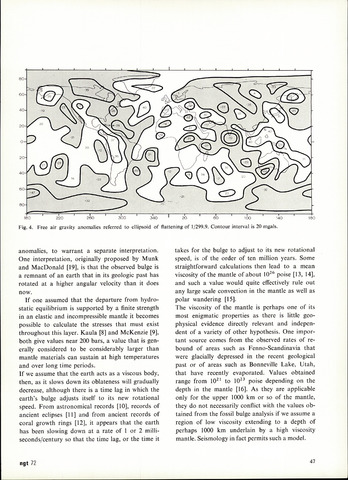anomalies, to warrant a separate interpretation.
One interpretation, originally proposed by Munk
and MacDonald [19], is that the observed bulge is
a remnant of an earth that in its geologic past has
rotated at a higher angular velocity than it does
now.
If one assumed that the departure from hydro
static equilibrium is supported by a finite strength
in an elastic and incompressible mantle it becomes
possible to calculate the stresses that must exist
throughout this layer. Kaula [8] and McKenzie [9],
both give values near 200 bars, a value that is gen
erally considered to be considerably larger than
mantle materials can sustain at high temperatures
and over long time periods.
If we assume that the earth acts as a viscous body,
then, as it slows down its oblateness will gradually
decrease, although there is a time lag in which the
earth's bulge adjusts itself to its new rotational
speed. From astronomical records [10], records of
ancient eclipses [11] and from ancient records of
coral growth rings [12], it appears that the earth
has been slowing down at a rate of 1 or 2 milli
seconds/century so that the time lag, or the time it
takes for the bulge to adjust to its new rotational
speed, is of the order of ten million years. Some
straightforward calculations then lead to a mean
viscosity of the mantle of about 1026 poise [13, 14],
and such a value would quite effectively rule out
any large scale convection in the mantle as well as
polar wandering [15].
The viscosity of the mantle is perhaps one of its
most enigmatic properties as there is little geo
physical evidence directly relevant and indepen
dent of a variety of other hypothesis. One impor
tant source comes from the observed rates of re
bound of areas such as Fenno-Scandinavia that
were glacially depressed in the recent geological
past or of areas such as Bonneville Lake, Utah,
that have recently evaporated. Values obtained
range from 1021 to 1023 poise depending on the
depth in the mantle [16]. As they are applicable
only for the upper 1000 km or so of the mantle,
they do not necessarily conflict with the values ob
tained from the fossil bulge analysis if we assume a
region of low viscosity extending to a depth of
perhaps 1000 km underlain by a high viscosity
mantle. Seismology in fact permits such a model.
Fig. 4. Free air gravity anomalies referred to ellipsoid of flattening of 1/299.9. Contour interval is 20 mgals.
ngt 72
47

